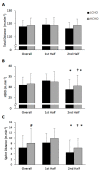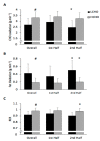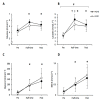The Effects of Pre-Game Carbohydrate Intake on Running Performance and Substrate Utilisation during Simulated Gaelic Football Match Play
- PMID: 33919043
- PMCID: PMC8142997
- DOI: 10.3390/nu13051392
The Effects of Pre-Game Carbohydrate Intake on Running Performance and Substrate Utilisation during Simulated Gaelic Football Match Play
Abstract
Background: Previous research has reported that elite Gaelic football players' carbohydrate (CHO) intakes are sub-optimal, especially, in the lead up to competitive matches. Despite clear decrements in running performance across elite Gaelic football matches, there are no studies that have investigated nutrition interventions on match-related Gaelic football performance. The aim of this study was to determine whether a higher-CHO diet in line with sports nutrition guidelines can improve Gaelic football-related performance compared to lower CHO intakes previously observed in Gaelic footballers.
Methods: Twelve Gaelic football players completed a Gaelic football simulation protocol (GFSP) on two occasions after consuming a high-CHO diet (7 g·kg-1) (HCHO) or an energy-matched lower-CHO diet (3.5 g·kg-1) (L-CHO) for 48 h. Movement demands and heart rate were measured using portable global positioning systems devices. Countermovement jump height (CMJ) and repeated-sprint ability (RSA) were measured throughout each trial. Expired respiratory gases were collected throughout the trial using a portable gas analyser. Blood samples were taken at rest, half-time, and post-simulation.
Results: There was no significant difference in total distance (p = 0.811; η2 = 0.005) or high-speed running distance (HSRD) covered between both trials. However, in the second half of the HCHO trial, HSRD was significantly greater compared to the second half of the LCHO trial (p = 0.015). Sprint distance covered during GFSP was significantly greater in HCHO (8.1 ± 3.5 m·min-1) compared with LCHO (6.4 ± 3.2 m·min-1) (p = 0.011; η2 = 0.445). RSA performance (p < 0.0001; η2 = 0.735) and lower body power (CMJ) (p < 0.0001; η2 = 0.683) were significantly greater during the HCHO trial compared to LCHO. Overall CHO oxidation rates were significantly greater under HCHO conditions compared to LCHO (3.3 ± 0.5 vs. 2.7 ± 0.6 g·min-1) (p < 0.001; η2 = 0.798). Blood lactate concentrations were significantly higher during HCHO trial versus LCHO (p = 0.026; η2 = 0.375). There were no significant differences in plasma glucose, non-esterified fatty acids (NEFAs), and glycerol concentration between trials. In both trials, all blood metabolites were significantly elevated at half-time and post-trial compared to pre-trial.
Conclusion: These findings indicate that a higher-CHO diet can reduce declines in physical performance during simulated Gaelic football match play.
Keywords: Gaelic games; carbohydrate; running performance; substrate utilisation.
Conflict of interest statement
The authors declare no conflict of interest.
Figures






Similar articles
-
Positional Match Running Performance in Elite Gaelic Football.J Strength Cond Res. 2016 Aug;30(8):2292-8. doi: 10.1519/JSC.0000000000001309. J Strength Cond Res. 2016. PMID: 26694505
-
Investigation in to the Positional Running Demands of Elite Gaelic Football Players: How Competition Data Can Inform Training Practice.J Strength Cond Res. 2020 Jul;34(7):2040-2047. doi: 10.1519/JSC.0000000000002492. J Strength Cond Res. 2020. PMID: 29533361
-
The Running Performance Profile of Elite Gaelic Football Match-Play.J Strength Cond Res. 2017 Jan;31(1):30-36. doi: 10.1519/JSC.0000000000001477. J Strength Cond Res. 2017. PMID: 27191694
-
Nutrition and Gaelic football: review, recommendations, and future considerations.Int J Sport Nutr Exerc Metab. 2015 Feb;25(1):1-13. doi: 10.1123/ijsnem.2013-0214. Epub 2014 Jun 5. Int J Sport Nutr Exerc Metab. 2015. PMID: 24901412 Review.
-
Match analysis and the physiological demands of Australian football.Sports Med. 2010 Apr 1;40(4):347-60. doi: 10.2165/11531400-000000000-00000. Sports Med. 2010. PMID: 20364877 Review.
Cited by
-
Dietary Macronutrients and Circulating Nonesterified Fatty Acids: A Secondary Analysis of the OMNI Heart Crossover Trial.J Nutr. 2023 Jan 14;152(12):2802-2807. doi: 10.1093/jn/nxac187. J Nutr. 2023. PMID: 36026540 Free PMC article. Clinical Trial.
-
Continuous Monitoring of Interstitial Fluid Glucose Responses to Endurance Exercise with Different Levels of Carbohydrate Intake.Nutrients. 2023 Nov 10;15(22):4746. doi: 10.3390/nu15224746. Nutrients. 2023. PMID: 38004140 Free PMC article.
-
Perception of faculty in the community health sciences colleges towards simulation-based education in clinical nutrition undergraduate practical courses.BMC Med Educ. 2024 Apr 11;24(1):402. doi: 10.1186/s12909-024-05338-w. BMC Med Educ. 2024. PMID: 38605334 Free PMC article.
References
-
- Malone S., Solan B., Collins K., Doran D. The metabolic power and energetic demands of elite Gaelic football match play. J. Sports Med. Phys. Fit. 2016;57:543–549. - PubMed
-
- Gamble D., Spencer M., McCarren A., Moyna N. Activity profile, PlayerLoad™ and heart rate response of Gaelic football players: A pilot study. J. Hum. Sport Exerc. 2019;14:14. doi: 10.14198/jhse.2019.144.01. - DOI
Publication types
MeSH terms
Substances
LinkOut - more resources
Full Text Sources
Other Literature Sources
Medical
Miscellaneous

